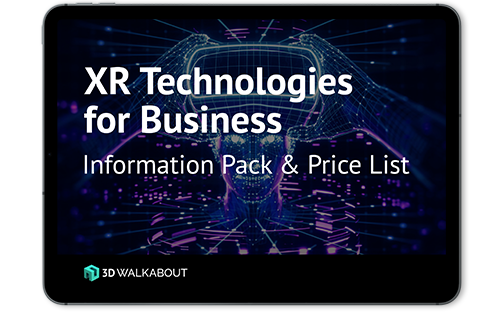In this article we’ll explore the past, present and future of education in the metaverse. Join us as we dive into how immersive technology like virtual reality, augmented reality and mixed reality are used in classrooms and what this means for future metaverse development.
Immersive technologies, Virtual Reality, Augmented Reality and Mixed Reality have a profound impact on learning. We see this in workplace training. Companies like Shell, Rio Tinto, Boeing, DHL, and NASA, are all using them to upskill and onboard their employees. We see this in classrooms around the world, where kids and adults alike are going on virtual field trips, pulling apart virtual machinery with holograms, and seeing historical ruins how they were at their peak.
A metaverse is a virtual world or multiple smaller virtual worlds connected together into a new version of the internet with spatial dimensions.
An educational metaverse is this but full of educational simulations and activities. It can house a science lab, the colosseum, and behind another door the entire solar system.
It’s little wonder that this technology shows promise for engaging students. Imagine learning the water cycle from the perspective of a droplet, or assembling your own atoms by grabbing protons, neutrons and electrons out of a virtual box. What 12 year old is going to choose to read a textbook when that’s on offer?
Immersive technology can simulate facts in context, and cover topics at greater depth than any diagram, textbook, or lecture. You can read about it, or you can live it?
Do any educational metaverse exist?
No Metaverses exist yet, if you’re a purist who believes that the metaverse is a single open platform like the internet.
If we are talking about explorable 3D spaces that are viewable with VR then there are literally thousands of examples.
In 2021, VictoryXR created the first “metaversity” when they scanned a copy of Morehouse College into a digital 3D environment. This is called a digital twin. It’s a to scale copy of a physical thing in a digital world. Inside the digital campus students can shrink themselves down and take tours through the human body, travel through space, and travel back in time to witness historical battles.
Students can visit this campus remotely, saving the need to commute, and there’s no limit on student size, equipment or any other resource.
This project caught the attention of Meta – Facebook’s parent company – which is now sponsoring the creation of 10 more virtual collages just like it.
“These environments will allow us to interact with 3D objects and explore through experience-based learning. If successful, the metaverse will break down the barriers of education, inviting people to learn with others whenever and wherever they want.” – Meta
The Chinese Communist Party is equally as committed to rushing the Metaverse into classrooms. Beijing made education a core pillar of its two-year Metaverse innovation and development plan. They have a system training students at cadres schools and have partnered with Microsoft to bring VR learning to public schools.
Roblox is a massively popular game. It’s a 3D world that shares several properties with what the metaverse is predicted to be. Recently they launched Roblox education.
This new innovation both teaches creators how to use their software to make educational content, and hosts the lessons they create for anyone to access. It’s a free platform with powerful software behind it that could lead to it becoming a major player in the space.
Why is immersive technology disrupting education now
If you’re reading this, and get the feeling that we are witnessing the beginning of something special in edtech, we agree. It’s exciting.
A silver lining to the Covid lockdowns and worldwide experiment in remote learning was it was a catalyst for the change we are now seeing.
For example, last year, the University of Cape Town started an online highschool. The curriculum is assessed by Cambridge, the lessons can be attended from anywhere, and it costs only $230US a month.
We think there’s so much innovation happening right now in edtech and it suggests a larger paradigm shift in the way we use the internet to learn.
It won’t stop at video calls and online portals. It can’t. Something’s lost over a Zoom call. There’s no feeling of being there, and it can’t compare to a face to face interaction.
Virtual reality, 3D simulations, and metaverses can help bridge that gap, potentially removing it completely.
Another virtual campus is being built by the Hong Kong University of Science and Technology (HKUST). Once finished, students in other countries and cities can attend classes virtually, and like we saw with Morehouse College’s virtual campus, all kinds of engaging digital experiences are possible.
Members of the University are going to scan the physical campuses to provide the source images for modeling the virtual twin.
They also have a mixed reality classroom in the works.
“The MC2 team is now working on the construction of the first mixed reality classroom on the HKUST(GZ) campus. The approximately 2,400 square feet state-of-the-art classroom – set to be completed by September 2022, will complement a similar classroom that will soon be constructed on the Clear Water Bay campus. The facilities will allow faculty and students of the two campuses to attend the same lecture at the same time in two paralleled physical spaces. Meanwhile, the team will also continue to enhance the virtual world’s display details in order to offer the best metaverse experience for the HKUST community.”
Why learn in virtual reality
What is it about learning with immersive technology that’s led to an $8 billion industry in less than a decade?
A study conducted at the University of Maryland found that people remember information better and have a higher recall when that info is presented in VR compared to a two-dimensional screen.
Two groups were taught the same material. One was given 2D resources to learn it. The other, an interactive VR simulation.
Afterwards, both groups took the same test.
Overall, participants in the VR group demonstrated 8.8% higher recall compared to those using flat screens. The median recall accuracy was almost 12% higher in VR (90.48% vs. 78.57% on the desktop).
It’s worth noting that since this study, the University of Maryland teamed up with Meta and VictoryXR and is one of the 10 universities we mentioned before that are building a digital twin of their campus for remote attendees.
A PWC study, called The Effectiveness of Virtual Reality Soft Skill Training in Enterprise, found that “The v-learners were up to 275% more confident to act on what they learned after training—a 40% improvement over classroom and 35% improvement over e-learn. V-learners were up to four times more focused than e-learners. They completed training on average four times faster than classroom training and 1.5 times faster than e-learn. V-learners were 3.75 times more emotionally connected to the content than classroom learners and 2.3 times more connected than e-learners. On top of those benefits, v-learn was estimated to be more cost-effective than classroom or e-learning modalities when delivered at scale.”
Dr Narendra Kini, according to the CEO at Miami Children’s Health System, that the retention level a year after a VR training session can be as much as 80 per cent, compared to 20 per cent retention after a week with traditional training.
The reasons why VR content is so sticky are well understood by educators. A teaching tool that engages more senses and asks students to apply what they’ve learned, outperforms sedentary and passive learning styles every time.
Building digital knowledge bases
Part of the reason why VR and AR are so popular in industries where employees need to undertake complex tasks is that they allow for the digitalization of instructions.
What was once a book of procedures can be distilled down into a set of holographic instructions that guide some through the steps they need to take.
This is just as applicable in the classroom. Every lesson that’s created in VR exists forever and is accessible at any time.
A virtual lesson can also generate analytics and assess competency. The role of tests is to uncover what students have learned but with a digital curriculum all input can be monitored and a test doesn’t need to feel like a test.
If millions of students all have access to the same repository of lessons, and we are constantly collecting information about their effectiveness then we can optimize them ad nauseum. We can A/B test two lessons and see what leads to the best learning outcomes and then make that available to every student. We can plug this data in models and algorithms that identify friction preventing understanding and erase it. The generation that grows up with that technology is going to change the world. If we play our cards right, that generation is already born.
Let’s wrap this up
VR and the Metaverse has the potential to radically change how we educate our society. Interactive lessons aren’t just more fun, the science says they are more effective too. Universities all around the world are building copies of their campuses and filling them with engaging digital experiences. These early movers are mainly deep pocket institutions and companies, but once these experiences are built then underprivileged schools stand to gain tremendously from the free and infinite resources of virtual environments. VR really is a science lab that fits in your backpack.
If you have an idea scratching at your brain and suspect it is the next hit app or service in VR education, call us and we’ll make it a reality: 1800 418 498.


